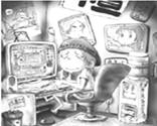ЬтФПФкШн
дФЖСЯТСаЖЬЮФЃЌДгУПЬтЫљИјЕФAЁЂBЁЂCЁЂDЫФИібЁЯюжаЃЌбЁГізюМббЁЯюЁЃ
I am a single working mother and going to college for a better life for my three-year-old child and myselfЃЎI am taking a nurse course called ЁАUrban CommunityЃЈЩчЧјЃЉЁБЃЎWe were asked to do a major project on problems in urban communitiesЃЎI chose the topic ЁАHomelessЁБЃЎ
Each day I would walk down the streets of the homeless and offer them something to drink and to eatЃЎI know itЁЏs tough to survive on the streetsЃЎLast night I ran into a group of 30 kids who were living on the streets in New YorkЃЎMy heart went out to them and I just wanted to cryЃЎBut I had to be strongЃЎ
I asked about their families and if they contacted them to let them know they were aliveЃЎMost of them said, ЁАNO!ЁБ They all looked like a happy family and they took care of one anotherЃЎI tried to persuade them to get help and to contact their families but they did not want toЃЎI did not want to make them to do it as they had their own reasonsЃЎ
All these kids were very respectfulЃЎNone of them was high on drugs nor were they drinkingЃЎSome of them enjoyed reading and writingЃЎSome of them enjoyed skateboarding, dancing and playing musicЃЎ
One girl asked me if I could give her a hug and I did soЃЎShe started to cry and said, ЁАThank you for not treating us as freaksЃЈЙжШЫЃЉlike everyone else doesЃЎPeople donЁЏt realize that we all have our own problems and some are worse than othersЃЎЁБ She told me that her stepfather ЃЈМЬИИЃЉ was extremely mean to her and her mother did not believe herЃЎShe ran awayЃЎHer street name was Little MaryЃЎ
They were good kids just trying to make ends meetЃЎI told them that I didnЁЏt have much to offer because I was a single mother just making ends meetЃЎI had offered them sandwiches and drinksЃЎThey were so happy to have something to eat and told me that I couldnЁЏt change the world but at least there was someone who really caredЃЎ
1.The author is _______ЃЎ
AЃЎa homeless mother with a three-year-old kid
BЃЎa single mother who attends college in New York
CЃЎa teacher who teaches the ЁАUrban CommunityЁБ course
DЃЎa full-time housewife with a three-year-old kid
2.What does ЁАMy heart went out to themЁБ in Paragraph 2 mean?
AЃЎMy heart was taken away by themЃЎ
BЃЎI wanted to hug them
CЃЎI felt sympathy for them
DЃЎI fell in love with them
3.What kind of feeling did the author show when she failed to persuade the children to contact their families?
AЃЎSorrow BЃЎAnxiety
CЃЎAnger DЃЎUnderstanding
4.Little Mary left home and became a wanderer because ________ЃЎ
AЃЎher stepfather didnЁЏt want to live with her
BЃЎher stepfather treated her so badly that she was injured
CЃЎher mother treated her so badly that she felt hurt
DЃЎher mother didnЁЏt believe her and her stepfather treated her badlyЃЎ
5.WhatЁЏs the best title for this passage?
AЃЎA Story of a Single Mother
BЃЎCare for the Homeless Kids
CЃЎAn Urban Community
DЃЎHow to Survive on the Streets
 ЬьЬьЯђЩЯвЛБОКУОэЯЕСаД№АИ
ЬьЬьЯђЩЯвЛБОКУОэЯЕСаД№АИ аЁбЇЩњ10ЗжжггІгУЬтЯЕСаД№АИ
аЁбЇЩњ10ЗжжггІгУЬтЯЕСаД№АИ

